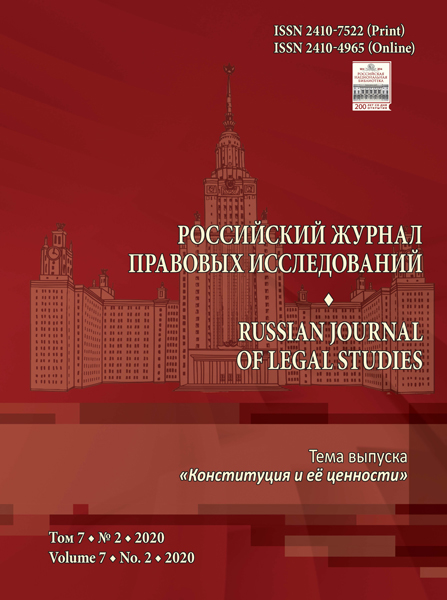Категории «интеграция» и «дезинтеграция» в международном праве: современные концептуальные подходы
- Авторы: Галушко Д.В.1
-
Учреждения:
- Финансовый университет при Правительстве Российской Федерации
- Выпуск: Том 7, № 2 (2020)
- Страницы: 71-77
- Раздел: Международно-правовые науки
- Статья получена: 12.08.2020
- Статья одобрена: 21.09.2020
- Статья опубликована: 02.11.2020
- URL: https://journals.eco-vector.com/2410-7522/article/view/42328
- DOI: https://doi.org/10.17816/RJLS42328
- ID: 42328
Цитировать
Полный текст
Аннотация
Значимость категории «интеграция» для современной системы международных отношений сложно переоценить. Именно этим объясняется пристальное внимание различных отраслей науки к данному понятию. Не стала исключением и наука международного права, развитие которой в последнее время во многом обусловлено происходящими повсеместно интеграционными процессами между государствами, основными субъектами международных правоотношений. Сама международно-правовая доктрина выработала немало подходов к характеристике интеграции, ее сущностных черт. Несмотря на объективный характер интеграции, ее развитие в контексте глобализации, последние дезинтеграционные события, происходящие на международной арене и порождающие кризисные явления, прежде всего, в функционировании Европейского Союза в связи с процессом выхода Великобритании из состава участников, предопределяют актуальность, а также теоретическую и практическую значимость настоящей статьи. Методологической основой работы стали известные общие и частные методы научного исследования. Целью и задачами статьи являются исследование соответствующих проблем и сути реальных интеграционных и дезинтеграционных процессов на международной арене, характеристика основных доктринальных подходов к ним, выявление общих тенденций, а также сущностных характеристик и основных черт данных явлений.
Ключевые слова
Полный текст
Об авторах
Дмитрий Вячеславович Галушко
Финансовый университет при Правительстве Российской Федерации
Автор, ответственный за переписку.
Email: galushkodv@gmail.com
ORCID iD: 0000-0002-9301-9565
SPIN-код: 1710-5918
Кандидат юридических наук, доцент, доцент Департамента правового регулирования экономической деятельности
РоссияСписок литературы
- Sideri S. Globalisation and Regional Integration. Eur J Dev Res. 1997;9(1):38-82. doi: https://doi.org/10.1080/09578819708426677.
- Тихомиров Ю.А. Цели и формы государственно-правовой интеграции // Правовое обеспечение межгосударственной интеграции. Сборник статей. М., 2005. С. 4–31.
- Smend R. Verfassung und Verfassungsrecht. Munchen: Duncker&Humblot, 1928.
- Kelsen H. Der Staat als Integration: Eine prinzipielle Auseinandersetzung. Vienna: Springer, 1930.
- Спенсер Г. Основные начала. СПб.: Альфарет, 2016.
- Гидденс Э. Устроение общества: Очерк теории структурации. М.: Академический Проект, 2005.
- Haas E. The Uniting of Europe. Stanford: Stanford University Press, 1958.
- Gonidec P.-F., Charvin R. Relations Internationales. Paris, 1984.
- Etzioni A. Political Unification: A Comparative Study of Leaders and Forces. N.Y.: Holt, Rinehart and Winston, 1965.
- Барановский В.Г. Политическая интеграция в Западной Европе. Некоторые вопросы теории и практики. М.: Наука, 1983.
- Сартори Д. Искажение концептов в сравнительной политологии (III) // Полис. Политические исследования. 2003. № 5. С. 65–75.
- Deutsch K. Analysis of International Relations. Englewood Cliffs, New Jersey: Prentice-Hall, 1968.
- Deutsch K. National Integration: Some Concepts and Research Approaches. Jerusalem Journal of International Relations, 1977;2(1):1-29.
- Wiener A., Diez Th. European Integration Theory. Oxford: Oxford University Press, 2009.
- Vollaard H. Explaining European Disintegration. Journal of Common Market Studies. 2014;(52):1142-1159. doi: https://doi.org/10.1111/jcms.12132.
- Haas E. The Study of Regional Integration: Reflections on the Joys and Anguish of Pretheorizing. In: Lindberg L.N., Scheingold S.A., editors. Regional Integration: Theory and Research. Cambridge, MA: Harvard University Press, 1971. P. 3-42.
- Webber D. How likely is it that the European Union will disintegrate? A critical analysis of competing theoretical perspectives. European Journal of International Relations. 2014;20(2):341-365. doi: https://doi.org/10.1177/1354066112461286.
- Hirschman A.O. Exit, Voice and Loyalty: Responses to Decline in Firms, Organizations and States. Cambridge, MA: Harvard University Press, 1970.
- Bartolini S. Restructuring Europe: Centre Formation, System Building, and Political Structuring between the Nation State and the European Union. Oxford: Oxford University Press, 2005. doi: https://doi.org/10.1093/0199286434.001.0001.
- Leuffen D., Rittberger B., Schimmelfennig F. Differentiated Integration: Explaining Variation in the European Union. Basingstoke: Palgrave Macmillan, 2013.
- Taylor P. The End of European Integration. London: Routledge; 2008. doi: https://doi.org/10.4324/9780203935682.
- Haas E.B. Collective Security and the Future International System. Denver, CO: University of Colorado Press, 1968.
- Lindberg L.N., Scheingold S.A. Europe’s Would-Be Polity: Patterns of Change in the European Community. Englewood Cliffs, NJ: Prentice-Hall, 1970.
- Mattli W. Ernst Haas's evolving thinking on comparative regional integration: of virtues and infelicities. Journal of European Public Policy. 2005;12(2):327-348. doi: https://doi.org/10.1080/13501760500044157.
- Rosamond B. Theories of European Integration. Basingstoke: Palgrave Macmillan, 2000.
- Mearsheimer J.J. Back to the Future: Instability in Europe after the Cold War. International Security. 1990;15(1):5-56.
- Rosato S. Europe's Troubles: Power Politics and the State of the European Project. International Security. 2011;35(4):45-86. doi: https://doi.org/10.1162/ISEC_a_00035.
- Lundestad G. ‘Empire’ by Integration: The United States and European Integration, 1945–1997. Oxford: Oxford University Press, 1998.
- Karvonen L. Europe's Spaces and Boundaries. Comparative European Politics. 2007;(5):441–460. doi: https://doi.org/ 10.1057/palgrave.cep.6110115.
- Jones E. Towards a theory of disintegration. Journal of European Public Policy. 2008;25(3):440-451. doi: https://doi.org/10.1080/13501763.2017.1411381.
Дополнительные файлы








